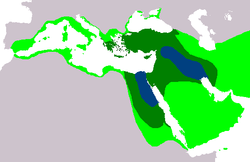Ugaritic alphabet
| Ugaritic | |
|---|---|
 The Ugaritic Writing System | |
| Script type | |
Time period | from around 1400 BCE |
| Direction | left-to-right |
| Languages | Ugaritic, Hurrian, Akkadian |
| ISO 15924 | |
| ISO 15924 | Ugar, 040 |
| Unicode | |
Unicode alias | Ugaritic |
Unicode range | U+10380–U+1039F |
The Ugaritic writing system is a cuneiform abjad (consonantal alphabet) used from around either the fifteenth century BCE[1] or 1300 BCE[2] for Ugaritic, an extinct Northwest Semitic language, and discovered in Ugarit (modern Ras Al Shamra), Syria, in 1928. It has 30 letters. Other languages (particularly Hurrian) were occasionally written in the Ugaritic script in the area around Ugarit, although not elsewhere.
Clay tablets written in Ugaritic provide the earliest evidence of both the North Semitic and South Semitic orders of the alphabet, which gave rise to the alphabetic orders of the reduced Phoenician Writing System and its descendants (including the Paleo-Hebrew aleph-bet, Hebrew, Syriac, Greek and Latin) on the one hand, and of the Ge'ez alphabet on the other which was also influenced by the ancient Egyptian Hieroglyphic writing system,[3] and adapted for Amharic. The Arabic and Ancient South Arabian scripts are the only other Semitic alphabets which have letters for all or almost all of the 29 commonly reconstructed proto-Semitic consonant phonemes. (But note that several of these distinctions were only secondarily added to the Arabic alphabet by means of diacritic dots.) According to Manfried Dietrich and Oswald Loretz in Handbook of Ugaritic Studies (eds. Wilfred G.E. Watson and Nicholas Wyatt, 1999): "The language they [the 30 signs] represented could be described as an idiom which in terms of content seemed to be comparable to Canaanite texts, but from a phonological perspective, however, was more like Arabic" (82, 89, 614).
The script was written from left to right. Although cuneiform and pressed into clay, its symbols were unrelated to those of Akkadian cuneiform.[4]
Function[]
Ugaritic was an augmented abjad. In most syllables only consonants were written, including the /w/ and /j/ of diphthongs. However, Ugaritic was unusual among early abjads in also writing vowels after the glottal stop. It is thought that the letter for the syllable /ʔa/ originally represented the consonant /ʔ/, as aleph does in other Semitic abjads, and that it was later restricted to /ʔa/ with the addition, at the end of the alphabet, of /ʔi/ and /ʔu/.[5][6]
The final consonantal letter of the alphabet, s2, has a disputed origin along with both "appended" glottals, but "The patent similarity of form between the Ugaritic symbol transliterated [s2], and the s-character of the later Northwest Semitic script makes a common origin likely, but the reason for the addition of this sign to the Ugaritic alphabet is unclear (compare Segert 1983:201-218; Dietrich and Loretz 1988). In function, [s2] is like Ugaritic s, but only in certain words – other s-words are never written with [s2]."[7] The words that show s2 are predominantly borrowings, and thus it is often thought to be a late addition to the alphabet representing a foreign sound that could be approximated by native /s/; Huehnergard and Pardee make it the affricate /ts/.[8] Segert instead theorizes that it may have been syllabic /su/, and for this reason grouped with the other syllabic signs /ʔi/ and /ʔu/.[9]
Probably the last three letters of the alphabet were originally developed for transcribing non-Ugaritic languages (texts in the Akkadian language and Hurrian language have been found written in the Ugaritic alphabet), and were then applied to write the Ugaritic language.[4] The three letters denoting glottal stop plus vowel combinations were used as simple vowel letters when writing other languages.
The only punctuation is a word divider.
Origin[]

At the time the Ugaritic script was in use (ca. 1300–1190 BCE),[10] Ugarit, although not a great cultural or imperial centre, was located at the geographic centre of the literate world, among Egypt, Anatolia, Cyprus, Crete, and Mesopotamia. Ugaritic combined the system of the Semitic abjad with cuneiform writing methods (pressing a stylus into clay). However, scholars have searched in vain for graphic prototypes of the Ugaritic letters in Mesopotamian cuneiform. Recently, some have suggested that Ugaritic represents some form of the Proto-Sinaitic alphabet,[11] the letter forms distorted as an adaptation to writing on clay with a stylus. (There may also have been a degree of influence from the poorly understood Byblos syllabary.[12]) It has been proposed in this regard that the two basic shapes in cuneiform, a linear wedge, as in